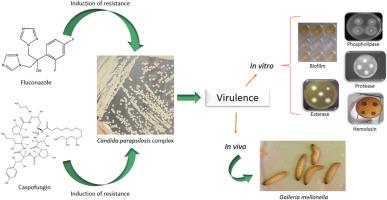假丝酵母菌复合种对氟康唑和卡泊菌素的体外诱导抗性:对其他抗真菌药的毒力和交叉抗性的影响
IF 3.5
3区 医学
Q3 IMMUNOLOGY
引用次数: 0
摘要
本研究探讨了氟康唑(FLC)和caspofungin (CSF)对假丝酵母(Candida parapsilosis)复合体耐药发展和毒力性状的影响。将17个分离株(6个敏感型梭菌、6个矫形梭菌和5个化生梭菌)暴露于FLC和CSF浓度增加的环境中,并测定暴露前后的最低抑制浓度(mic)。FLC和CSF的mic显著升高。值得注意的是,对一种抗真菌药物的诱导抗性影响了对其他抗真菌药物的敏感性,唑类药物(FLC、伊曲康唑和伏立康唑)和棘白菌素(CSF、anidulafungin和micafungin)的mic呈反比关系。此外,在对FLC和CSF均有诱导抗性的样品中,两性霉素B mic显著增加。在无抗真菌培养基中继代培养后,抗性表型基本保持稳定。抗真菌暴露增强了生物膜的形成,但对关键水解酶(酯酶、磷脂酶、蛋白酶和溶血素)的分泌没有显著影响。体内毒力在耐药诱导后保持不变,使用宽厚杆菌模型进行评估。我们的研究结果强调了傍孢霉复杂物种对抗真菌压力的适应性,强调了持续监测和开发新的治疗策略来管理这些病原体引起的感染的必要性。抗真菌暴露后生物膜形成的增加对感染管理提出了额外的挑战。本文章由计算机程序翻译,如有差异,请以英文原文为准。

In vitro induction of resistance to fluconazole and caspofungin in Candida parapsilosis complex species: Implications for virulence and cross-resistance to other antifungals
This study investigates the effects of progressive exposure to fluconazole (FLC) and caspofungin (CSF) on resistance development and virulence traits in the Candida parapsilosis complex. Seventeen isolates (6 C. parapsilosis sensu stricto, 6 C. orthopsilosis, and 5 C. metapsilosis) were exposed to increasing concentrations of FLC and CSF, and minimum inhibitory concentrations (MICs) were determined pre- and post-exposure. Significant increases in MICs for FLC and CSF were observed. Notably, induced resistance to one antifungal agent influenced susceptibility to other antifungals, with an inverse relationship between the MICs of azoles (FLC, itraconazole, and voriconazole) and echinocandins (CSF, anidulafungin, and micafungin). Additionally, there was a significant increase in amphotericin B MICs in samples with induced resistance to both FLC and CSF. Resistance phenotypes remained largely stable after subculturing in antifungal-free media. Antifungal exposure enhanced biofilm formation but did not significantly affect the secretion of key hydrolytic enzymes (esterase, phospholipase, protease, and haemolysin). In vivo virulence remained unchanged post-resistance induction, as assessed using the Galleria mellonella model. Our findings highlight the adaptability of C. parapsilosis complex species to antifungal pressure, underscoring the need for continuous surveillance and the development of novel therapeutic strategies to manage infections caused by these pathogens. The increase in biofilm formation following antifungal exposure presents additional challenges for infection management.
求助全文
通过发布文献求助,成功后即可免费获取论文全文。
去求助
来源期刊

Microbial pathogenesis
医学-免疫学
CiteScore
7.40
自引率
2.60%
发文量
472
审稿时长
56 days
期刊介绍:
Microbial Pathogenesis publishes original contributions and reviews about the molecular and cellular mechanisms of infectious diseases. It covers microbiology, host-pathogen interaction and immunology related to infectious agents, including bacteria, fungi, viruses and protozoa. It also accepts papers in the field of clinical microbiology, with the exception of case reports.
Research Areas Include:
-Pathogenesis
-Virulence factors
-Host susceptibility or resistance
-Immune mechanisms
-Identification, cloning and sequencing of relevant genes
-Genetic studies
-Viruses, prokaryotic organisms and protozoa
-Microbiota
-Systems biology related to infectious diseases
-Targets for vaccine design (pre-clinical studies)
 求助内容:
求助内容: 应助结果提醒方式:
应助结果提醒方式:


